Fans of South American cichlids know and love Jack Dempsey fish (Rocio octofasciata).
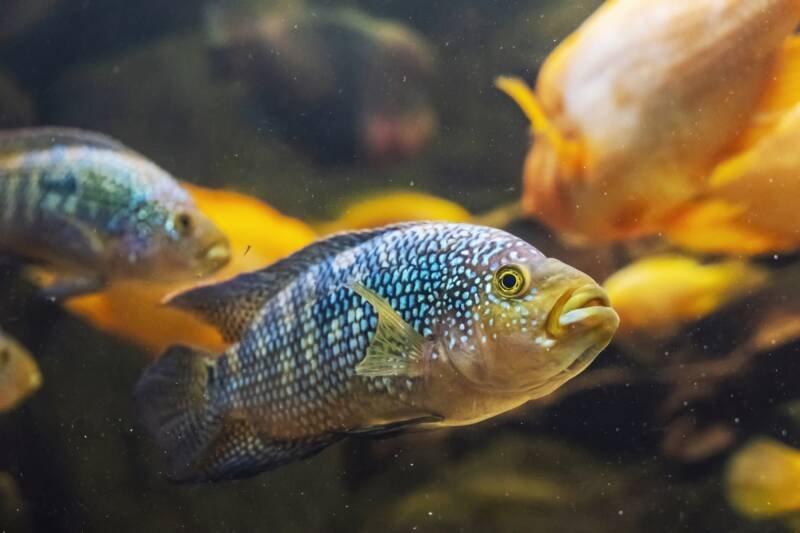
These brutes pack a powerful combination of attitude and stunning colors.
And while they require some careful management, they integrate into select community aquariums without a problem.
Jack Dempseys earned their name from the heavyweight boxer of the same name.
Reigning champion from 1919-1926, Dempsey had the nickname the “Manassa Mauler.”
His ruthless reputation and profile struck a chord with biologists, and they passed the name onto the fish.
Aquarists recognize the sloping profile and aggressive nature of Jack Dempseys. And if you don’t have experience with territorial fish, you should skip this cichlid.
However, they’re hardy in nature and relatively easy to care for – beyond that mean streak.
At a Glance
| Min tank size: | 80 gal (300 l) |
| School size: | one, depending on tank composition |
| Temp: | 74-85°F (23-29°C) |
| Lifespan: | 8–15 years |
| Size: | 10–15 inches (25–38cm) |
| pH: | 6.0-7.0 |
| Hardness: | 9-20 dH |
| Ammonia: | 0 ppm |
| Nitrite: | 0 ppm |
| Nitrate: | <40 ppm |
In this article
In the Wild
Originally, Jack Dempsey fish inhabited shallow, slow-moving waters in Belize, Guatemala, Honduras, and Mexico.
However, you can now find established populations in Australia and Thailand, where they’re known as Mexican blue frontosa.
These non-American populations arose from escapees (intentional or otherwise).
Settling into the tropical waters, the Jack Dempseys are now invasive species in those regions.
It’s an essential lesson on NEVER releasing unwanted fish into the wild.
Jack Dempseys tolerate bogs, irrigation ditches, and streams. Water temperatures as high as 86°F (30°C) don’t phase them, and they prefer lower light levels.
In Central and Southern America, you can find them in natural caves.
Tank Size
Jack Dempsey fish are sexually dimorphic, with males growing larger than females.
In the wild, males top out around 15 inches (38 cm), and the females get approximately 10 inches (25 cm). You shouldn’t expect to see that in your tank, though.
In captivity, a more reasonable expectation is to see your male Jack Dempseys around that 10-inch (25 cm) mark, with females smaller at 8 inches (20 cm).
That’s provided you give them enough room, of course. Crowded fish never achieve their full potential.
Lifespan
If you’re contemplating adding Jack Dempsey fish to your community tank (or setting up a tank of strictly Jack Dempseys), make sure you’re ready for the commitment. These sassy cichlids have a lifespan between 8-15 years.
Of course, that range depends on the quality of their care.
Ensuring that you allow plenty of room to grow, stay on top of diet needs, and minimize triggers for fighting among the group (if you keep a school) will boost those years toward the maximum.
Behavior

Most aquarists know Jack Dempsey fish have an aggressive reputation. But they aren’t as familiar with the shy side of this colorful fish.
When first added to a new tank, Jack Dempseys often scatter to caves and into plants – even if you bring home a group.
You can ease this flighty panic by introducing your Jack Dempseys into a community aquarium with established dither fish.
Dither fish are schooling species that show nervous fish everything’s okay – maintaining normal activity levels.
Male Jack Dempseys have the highest aggression levels. If you only keep one in a tank, you’ll keep bullying problems to a minimum.
Ensuring plenty of cave options to allow everyone to set up a territory is another option. After all, these AREN’T schooling fish!
And, crazy as it sounds, the more fish you stock into your tank, the better off everyone will be.
Your Jack Dempseys will end up with TOO MANY options to pick a fight. Without one fish to single out for bullying, peace will reign in the aquarium. (But don’t overcrowd the tank!)
Octofasciata Tank Setup
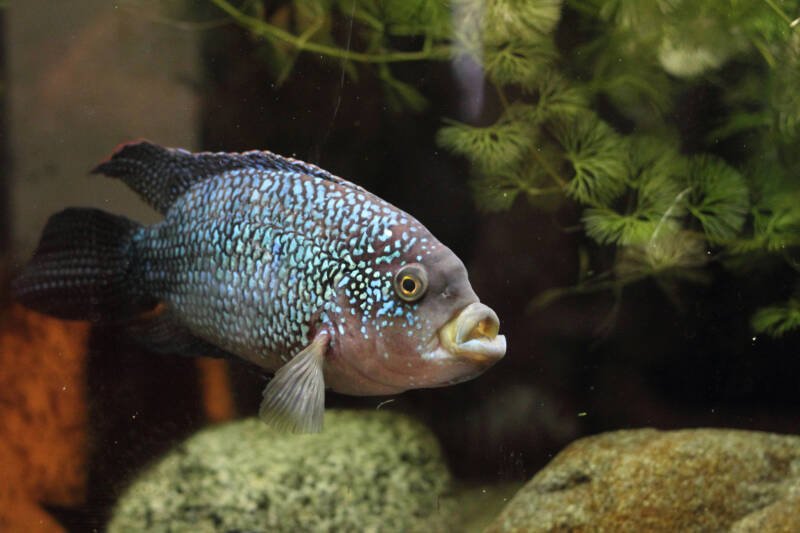
If you’re only looking to add one Jack Dempsey fish (perhaps as a centerpiece), an 80-gallon or 300 l tank will do the trick.
As soon as you want to keep a pair (or more), though, you need to up your game. Two means increasing to a 100-gallon (400 l) tank.
In the wild, Jack Dempseys stick to slow-moving streams and rivers. So while that hefty tank needs a matching filter, you don’t want to overdo the outflow.
And you can skip extra air stones – you won’t need to supplement the water current for these bruisers.
Water Conditions
Whether invading Australia and Thailand or haunting cenotes in South America, Jack Dempseys prefer tropical climes.
You want to keep that water temperature around 74-85°F (23-29°C). If you get a little warmer, they won’t mind, but don’t forget the other fish in the tank.
Jack Dempsey fish frequent streams with slightly soft, acidic waters.
You want to try to match those conditions as closely as possible. As such, aim for a pH level of 6.0-7.0 and a hardness of 9-20 dH.
Keep a close eye on your water quality. If the ammonia or nitrate goes above 0 ppm, it’ll start to impact the immune system of your Jack Dempseys.
The stress will result in your fish showing paler colors – your head’s up that there’s a problem.
Decorating the Jack Dempsey Fish Tank
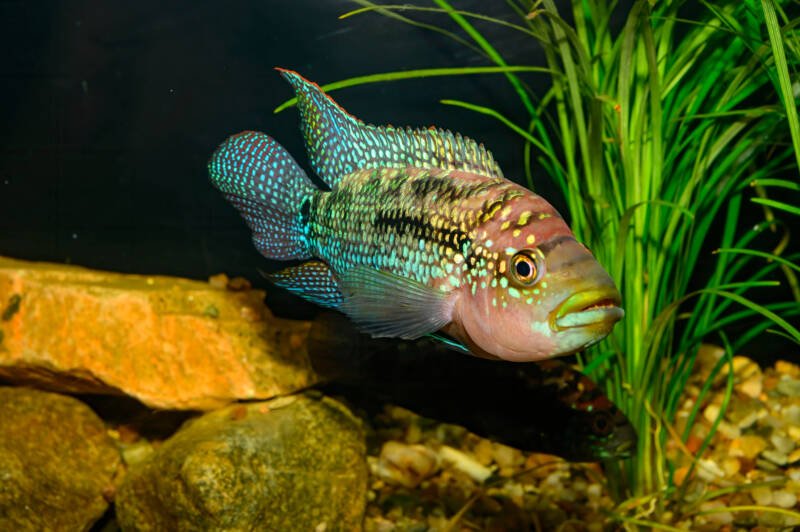
Decorating cichlid aquariums always presents a challenge.
Like any other cichlid, Jack Dempseys enjoy digging in the substrate and rearranging all of your hard work. It’s nothing personal; it’s just their way.
As such, consider using sand or fine gravel on your tank bottom. Sand will settle back out when your Jack Dempsey finishes digging.
But skip “cichlid sands.” They contain aragonite – a form of calcium carbonite. It’ll leach into the water and increase the pH and hardness.
Jack Dempsey fish stick to the carnivore side of the menu, so they won’t eat the plants in the tank, but their digging can uproot anything you try to use.
Anubias, Java Fern, and Vallisneria provide great hiding cover for them and root deep into the substrate.
If you want a better compromise, though, consider floating plants.
Your Jack Dempseys won’t bother them, and they’ll cut down on the lighting, creating the dim conditions your fish prefer:
- Frogbit
- Hornwort
- Pennywort
- Water lettuce
- Water sprite
Don’t forget that shy side to your Jack Dempseys. Each fish needs a cave to call their own, with plenty of space around it.
This gives them somewhere to hide, with a territory to defend. It’ll also provide another dark place for them to retreat to.
Jack Dempsey Fish in Communities
Many aquarists think the nasty streak Jack Dempsey fish are known for means they can’t fit into community aquariums.
However, if you’re sticking to a lone male or choosing the proper tank mates, these gorgeous cichlids do just fine in mixed company.
Tank Mates
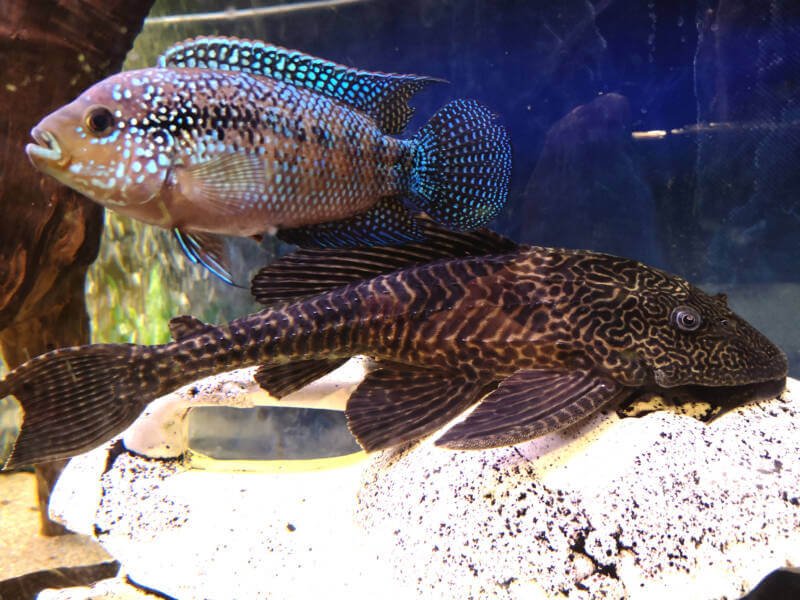
Your best bet for harmony is to choose fish of a similar size and attitude.
Your Jack Dempseys won’t bully anyone if they aren’t the biggest fish in the pond (so to speak). The following fish work out surprisingly well:
And, of course, if you want to keep a tank full of Jack Dempseys, you have that option. You just need adequate space for everyone in the group.
And you’re still better off keeping one male in a group of females to maintain the peace.
Incompatible Species
Any fish small enough to fit in your Jack Dempsey’s mouths are out. These carnivores can’t resist an easy-to-catch snack.
So while tetras frequent the same regions in the wild, you should skip adding them to your community aquarium.
And while it’s popular to mix invertebrates into tanks these days, they don’t work well with Jack Dempseys!
Cichlids are opportunistic feeders, and they have no problem snatching up your freshwater shrimp or snails.
Diet & Feeding
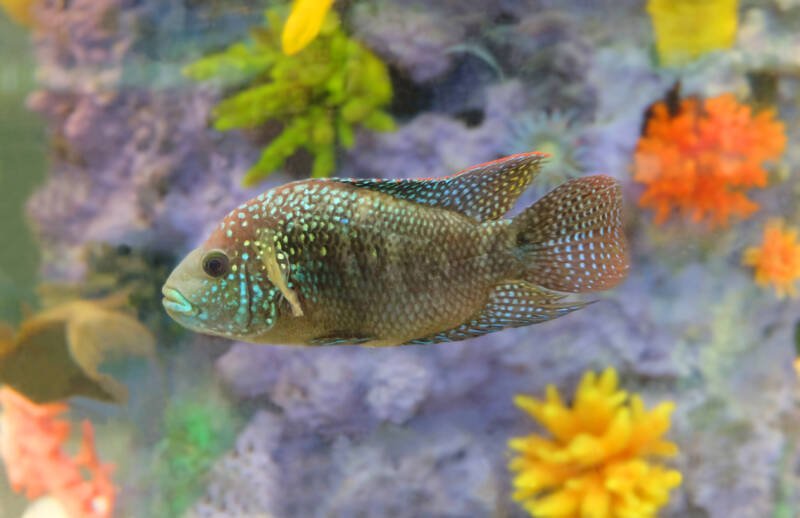
Jack Dempsey fish fall squarely on the carnivore side of the menu. And they aren’t picky about where that protein comes from.
However, if you want to stave off potential health problems, YOU need to stay picky about what you offer.
You can find processed fish foods designed with carnivores in mind.
Omega One Cichlid Pellets and Fluval Bug Bites Cichlid Formula cater to a high-protein diet, and Jack Dempseys don’t mind chowing down on these large chunks.
However, make sure you incorporate some live, frozen, or freeze-dried protein options into the mix. You’ll keep those blue, red, gold, and pink colors looking their brightest.
They’re also the best options when you’re getting fish ready for breeding:
- Bloodworms
- Brine shrimp
- Crickets
- Fruit flies
- Grasshoppers
- Shrimp
And just because they prefer the meaty side of things doesn’t mean you should neglect their servings of vegetables.
Whether you decide to make homemade fish food or chop and add veggies now and then, a dose of greens still matters:
- Cabbage
- Dandelion leaves
- Lettuce
Breeding: Parental Cooperation
Breeding Jack Dempsey fish requires a separate breeding tank and patience.
However, getting to see two fish working together to raise their fry is a unique experience. So if you feel up to the task and have the room, it’s worth it.
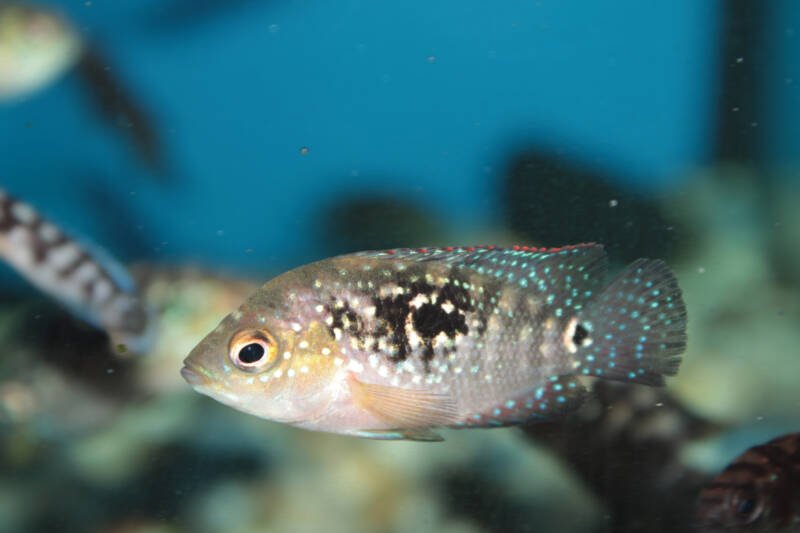
Males or Females?
Jack Dempsey fish males reach a larger size than females. The dorsal and anal fins are longer in size and come to sharper points.
They also sport a brighter coloration, though that may get difficult to see during spawning season (more on that in a minute).
Of course, males have that more aggressive streak. If you’ve done all of your work correctly, though, you may or may not notice this as readily as the other cues.
So check the fins, size, and then do a spot count. (Females have fewer spots across their bodies than males)
Coordination
Unless you want to run the risk of mutant fry, purchase your male and female Jack Dempsey fish from different stores. This will ensure that you have different bloodlines.
If breeding is your goal, you’ll want to set everyone up in the same tank from the beginning.
If you wait until your Jack Dempseys are mature and pair two together, you could end up with a brutalized female.
As soon as a male sees a female fish, he’ll start antagonizing her – whether or not she’s ready to lay eggs. This is dangerous, and repeated attacks may kill her.
Waiting until your fish naturally pair off together prevents that damage. You’ll know the time’s right when your fish darken in color.
Fun fact: Jack Dempseys change color throughout their lives. As juveniles, they’re grey; adults take on gorgeous hues; spawners go almost black.
The breeding tank should stay as clean and conditioned as your community tank.
Setting the temperature to 84°F (29°C) triggers the spawning drive.
And make sure there are flat stones at the bottom of the tank – your Jack Dempseys need them for an egg-laying site!
NO other fish can go in the breeding tank! Jack Dempseys will pursue and kill other fish once they’ve paired off and settled down to mate.
You CANNOT leave them in the community tank, or you’ll end up with utter devastation. (A separate breeding tank is MANDATORY!)
The pair will clean off their chosen rock by blowing the sand away. The female then lays up to 500 eggs on the surface.
Both of them then set to work digging pits in the nearby sand. After three days, the eggs hatch.
The pair catch the fry and usher them to the sandpits. Both parents guard the young over the next ten days.
They crush and release food to feed the tiny fry until they’re large enough to swim independently.
Of course, if the parents get stressed, they eat their fry, so make sure you keep everyone happy.
Health & Disease
Jack Dempsey fish have a sturdy reputation. After all, in the wild, they tolerate high water temperatures and low oxygen levels.
However, they still need top water quality and a balanced diet to prevent some nasty health problems.
Head and Lateral Line Erosion (HLLE) crops up whenever poor nutrition happens. You’ll see pits forming on your Jack Dempsey’s head.
Fixing the diet will resolve the problem, as will checking to make sure your water quality hasn’t slipped.
You also need to keep an eye out for two skin flukes:
- Dactylogyrus spp.
- Gyrodactylus spp.
The flukes use an adapted mouth part to attach to the skin and gill cover of your Jack Dempsey.
If left untreated, lesions result, and develop pockets of mucus. Each lesion is a potential source for infection to invade.
Make sure you stay on top of your water changes.
Jack Dempsey Fish: Are They for You?
While Jack Dempsey fish reach impressive sizes and look stunning in a tropical aquarium, they aren’t out of reach – even for aquarists of modest means. Fish run around $5 – $10, on average.
Of course, if you want one of the rarer color variations out there, you’ll have to pay more.
The electric blue Jack Dempsey (around $30) is one of those varieties. Smaller than the standard Jack Dempsey, this fish has iridescent blue scales.
No one’s quite sure whether they’re a variant of a wild type or engineered from selective breeding.
If you’re a fan of Jack Dempseys but leery of that aggressive streak – and you have money saved up – the electric blue variety may be up your aisle.
This particular variety has a less aggressive reputation than its larger cousin.
Of course, you can’t go wrong with any of the Jack Dempseys.
There’s something so striking about those dancing patterns across the sides and gill covers.
With such a variety of colors to choose from, even a little mean streak seems worth it.
Closing Thoughts
Jack Dempsey fish may have taken their name from a heavyweight boxer, but they’ve earned their place in aquarium popularity from their gorgeous color patterns.
They need careful management for their aggressive streak, but that much beauty is worth it.
Do you have Jack Dempseys? Just one or a school?
Have you seen them breed?
Share your stories and questions with us here!